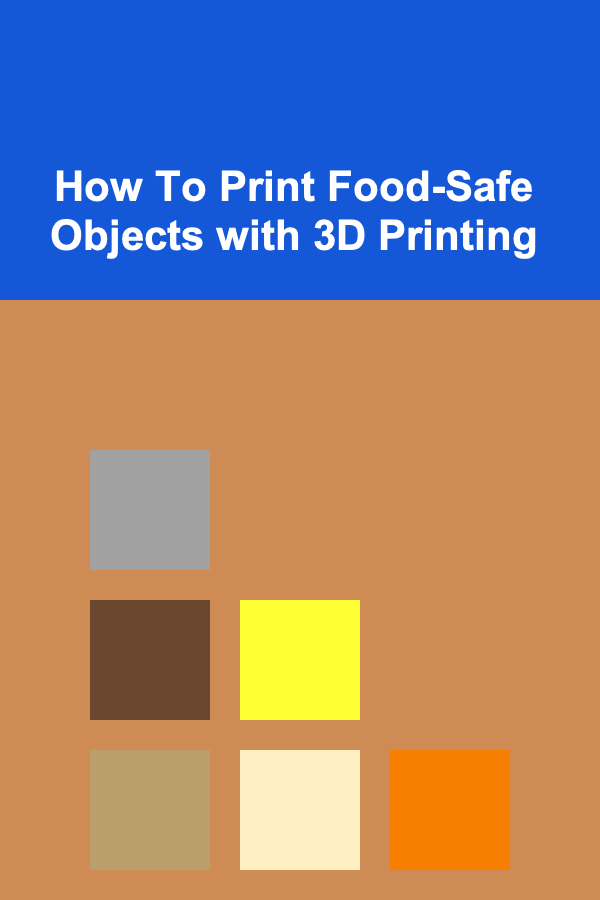
How To Print Food-Safe Objects with 3D Printing
ebook include PDF & Audio bundle (Micro Guide)
$12.99$8.99
Limited Time Offer! Order within the next:

3D printing, also known as additive manufacturing, has revolutionized the way we produce objects, allowing for the creation of highly customized and intricate designs. One of the most fascinating applications of this technology is the production of food-safe objects. With the right materials, tools, and techniques, it is possible to 3D print objects that are safe for contact with food, opening up new possibilities in kitchenware, utensils, and even food preparation tools.
In this article, we will explore how to print food-safe objects using 3D printing, including the key considerations, materials, and processes involved. By understanding the various factors that affect the safety and usability of 3D printed objects in food-related applications, you can ensure that your creations are both functional and safe to use.
Understanding Food Safety in 3D Printing
When it comes to creating food-safe objects, the first consideration is the safety of the materials used in the 3D printing process. Since 3D printed objects often come into direct contact with food, it is crucial that the materials chosen for printing do not release harmful chemicals or toxins into the food. In addition, the surface texture and cleanliness of the printed object must be taken into account to avoid the growth of bacteria or mold.
Key Factors Affecting Food Safety in 3D Printing
- Material Composition: Not all 3D printing materials are suitable for use in food-related applications. Some materials may contain toxic additives, chemicals, or heavy metals that can leach into food. It is important to choose materials that are certified as food-safe by relevant regulatory bodies or that are known to be non-toxic and safe for contact with food.
- Surface Texture: 3D printed objects often have a rough surface due to the layer-by-layer printing process. A rough surface can harbor bacteria and mold, which can lead to contamination. Smoothing the surface of the printed object, either through post-processing techniques or by selecting a material with a smoother finish, can help reduce the risk of contamination.
- Post-Processing: Even though the material used in the 3D printing process may be food-safe, post-processing steps such as cleaning, sealing, and coating are essential to ensure that the object is safe for use with food. Proper cleaning removes any residue from the printing process, while sealing or coating the surface can help make it more durable and resistant to contamination.
- Temperature Resistance: Many food-related applications, such as baking or cooking, involve exposure to heat. It is important to ensure that the material used in 3D printing can withstand the temperatures typically encountered in food preparation without degrading or releasing harmful substances.
Selecting Food-Safe 3D Printing Materials
One of the most important decisions when 3D printing food-safe objects is selecting the right material. Various types of filaments and resins can be used in 3D printing, but not all of them are suitable for food-related applications. The materials chosen must meet specific criteria to ensure safety, durability, and functionality.
Common Food-Safe 3D Printing Materials
- PLA (Polylactic Acid): PLA is one of the most commonly used 3D printing filaments, and it is derived from renewable resources such as cornstarch or sugarcane. PLA is generally considered non-toxic, making it a popular choice for creating food-safe objects. However, PLA is not always recommended for objects that will come into contact with hot food, as it has a relatively low melting point (around 180°C to 220°C). For most kitchenware applications that do not involve heat, PLA can be a safe and affordable option.
- PETG (Polyethylene Terephthalate Glycol): PETG is a durable and heat-resistant material that is often used for food-safe 3D printing applications. It is more heat-resistant than PLA and has a smooth surface that is easier to clean. PETG is commonly used for printing food containers, utensils, and other kitchen tools because it is resistant to chemicals and moisture. It is also FDA-approved for food contact, making it a safe choice for food-related objects.
- Nylon: Nylon is another food-safe material that is known for its strength, flexibility, and resistance to wear and tear. Nylon can withstand higher temperatures than PLA and PETG, making it a good option for objects that will be exposed to heat. However, nylon can be more difficult to print with, and it may require specialized equipment and expertise to achieve the desired results. Additionally, nylon is more porous than PLA or PETG, which can make it harder to clean effectively. It is important to seal the surface of nylon objects if they are to be used for food applications.
- TPU (Thermoplastic Polyurethane): TPU is a flexible material that is often used for 3D printing objects that require elasticity, such as grips, seals, or gaskets. While TPU is not as commonly used for food-safe applications as PLA or PETG, it can be considered safe for food contact in some cases. Like nylon, TPU has a more porous surface, so it may require sealing or coating to ensure it is safe for food use.
- Food-Safe Resin: In addition to filament-based 3D printing, resin-based printing (such as SLA or DLP printing) is also commonly used. Some resins are formulated specifically to be food-safe, but they are typically more expensive than standard 3D printing filaments. It is essential to verify that the resin used is certified as food-safe before printing any objects that will come into contact with food. Post-processing steps, such as curing and cleaning, are critical for ensuring the safety of resin-printed objects.
Materials to Avoid
Certain materials should be avoided when printing food-safe objects, as they may contain harmful chemicals or release toxic substances when exposed to food. These include:
- ABS (Acrylonitrile Butadiene Styrene): While ABS is a widely used 3D printing material, it is not considered food-safe. It can release harmful chemicals, such as styrene, when heated or exposed to food. ABS should not be used for objects that will come into direct contact with food.
- HIPS (High Impact Polystyrene): Similar to ABS, HIPS is another material that should be avoided for food-related applications. It is not certified as food-safe, and it can release potentially harmful substances.
- PVC (Polyvinyl Chloride): PVC is a common plastic used in many applications, but it is not suitable for food contact. It contains chlorine, which can release toxic fumes when heated.
Post-Processing for Food Safety
While the material selection is critical for food safety, post-processing steps are equally important to ensure that 3D printed objects are safe for use with food. Here are some essential post-processing steps to consider:
1. Cleaning: After printing, objects should be thoroughly cleaned to remove any residue from the 3D printing process, such as support material, oils, or dust. This can be done using warm water and mild soap, or with specialized cleaning solutions designed for 3D printed objects. It is important to clean the object before it comes into contact with food to avoid contamination.
2. Smoothing the Surface: 3D printed objects often have a rough surface due to the layer-by-layer nature of the printing process. A rough surface can harbor bacteria, making the object unsuitable for food contact. To smooth the surface, you can use techniques such as sanding, polishing, or coating the object with a food-safe sealant. Smoothing the surface not only makes the object safer to use but also improves its appearance and functionality.
3. Sealing or Coating: Sealing or coating the surface of 3D printed objects can provide an additional layer of protection against contamination. There are various food-safe coatings available, such as epoxy resins, polyurethane, or silicone, that can be applied to the surface of the printed object to create a smooth, non-porous surface. This can help prevent bacteria from being trapped in the object's surface and make it easier to clean.
4. Curing: For resin-based 3D printing, proper curing is essential to ensure that the printed object is fully hardened and free of uncured resin. Uncured resin can leach harmful chemicals into food. After printing, the object should be exposed to UV light to ensure that it is completely cured and safe for use with food.
Practical Applications of Food-Safe 3D Printing
Food-safe 3D printing opens up a wide range of possibilities for creating customized kitchen tools and food-related objects. Some of the most common applications include:
- Custom Utensils and Molds: 3D printing allows for the creation of highly customized utensils, molds, and cookie cutters. Whether you need a specific shape for baking or a personalized tool for cooking, 3D printing provides the flexibility to create exactly what you need.
- Food Containers: With the right materials, you can create custom food containers that are safe for storing food. Whether for meal prep, storage, or serving, 3D printed containers can be designed to meet your specific needs.
- Replacement Parts: If you have a kitchen appliance or tool that needs a replacement part, 3D printing can provide an affordable and quick solution. For example, 3D printed parts can be used to replace handles, knobs, or seals on various kitchen devices.
- Food Decor: 3D printing can also be used to create intricate food decorations or garnishes. For example, customized chocolate molds, cake toppers, or cookie decorations can all be created with food-safe materials.
Conclusion
3D printing offers exciting possibilities for creating food-safe objects that are highly customizable and tailored to specific needs. By choosing the right materials, following proper post-processing techniques, and ensuring that the printed object is fully cleaned and sealed, you can create safe and functional kitchen tools, utensils, and containers. Whether you are looking to create personalized food items or simply enhance your cooking experience, food-safe 3D printing provides a versatile solution for innovation in the kitchen.

Cutting Down on Takeout and Eating Out: Delicious Alternatives You'll Love
Read More
How to Establish a Veterinary Care Checklist for Your Pet
Read More
How to Interpret Fibonacci Retracements for Crypto Trading
Read More
How to Use Clipboards for Displaying Recipes While Cooking
Read More
The Role of Art in Feng Shui: Decorating with Intention
Read More
How to Choose a Credit Card for Balance Transfers
Read MoreOther Products

Cutting Down on Takeout and Eating Out: Delicious Alternatives You'll Love
Read More
How to Establish a Veterinary Care Checklist for Your Pet
Read More
How to Interpret Fibonacci Retracements for Crypto Trading
Read More
How to Use Clipboards for Displaying Recipes While Cooking
Read More
The Role of Art in Feng Shui: Decorating with Intention
Read More